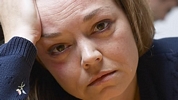Molluscum contagiosum is a common disease that is caused by a poxvirus that infects only the skin. This virus enters the skin through small breaks in the skin barrier. After an incubation period, growths appear. These growths can develop anywhere on the skin. Like warts, which are caused by a different virus, molluscum contagiosum is considered benign. Molluscum contagiosum does not affect any internal organs and rarely causes symptoms. They are usually small flesh-colored or pink dome-shaped growths that often become red or inflamed.
As the name implies, molluscum contagiosum is contagious. They may appear shiny and have a small central indentation or white core. Because they can spread by skin-to-skin contact, molluscums are usually found in areas of skin that touch each other such as the folds in the arm or groin. They also are found in clusters on the chest, abdomen, and buttocks and can appear on the face and eyelids. Sometimes, the growths appear in a row. In people who have a disease that weakens the immune system, the molluscum may be very large in size and number, especially on the face.
Molluscum contagiosum spreads in three ways. One who has molluscum contagiosum can spread the virus to other parts of the body. This may happen by rubbing or scratching a growth and then touching unaffected skin. Molluscum contagiosum also spreads from person to person through direct skin-to-skin contact. And it is possible to get the disease by coming into contact with an object that has touched infected skin such as a towel, toy, or clothing. There have been reports of people contracting molluscum contagiosum from a swimming pool or gymnastic mat.
Children tend to get molluscum more often than adults. It is common in young children who have not yet developed immunity to the virus. Children also tend to have more direct skin-to-skin contact with others. Anyone who is exposed to the virus through skin-to-skin contact has an increased risk of developing molluscum contagiosum. This may happen by participating in a close contact sport such as wrestling or having sexual contact with an infected person. Living in a tropical area also increases the risk. The virus thrives in areas that are warm and humid.
Certain medical conditions also make a person more susceptible. People who have atopic dermatitis or a disease that weakens the immune system are more likely to develop molluscum contagiosum. While molluscum contagiosum will eventually go away on its own without leaving a scar, many dermatologists advise treating. Treatment can prevent the growths from spreading to other areas of a patient's body and to other people. Before treatment begins, a dermatologist may confirm that the growths are molluscum by scraping an area of infected skin and looking at the cells under a microscope.
If molluscum contagiosum is present, there are a number of treatment options. Treatment for molluscum is similar to that for warts. Growths can be frozen with liquid nitrogen, destroyed with various acids or blistering solutions, or treated with an electric needle and scraped off with a sharp instrument. Laser therapy also has been effective in treating molluscum. All of these treatments can be performed in a dermatologist's office. If there are many growths, treatment sessions may be needed at regular intervals until the growths disappear. Some discomfort is associated with these treatments.
Plant medicinecancounter molluscumcontagiosumrapidly utilizing the powerful forces of its monoterpenes. These micro particles provide the most rapid absorption; they enter cell membranes with incredible swiftness and have a direct antiviral effect against molluscum. This results in elimination of molluscum, often within several days. The lipophilic characteristic of plant medicine allows it to penetrate deeply. It is absorbed in the skin and into the system in trace quantities. It therefore not only has a direct virucidal effect against molluscum but provides total systemic support.
The advantage of chemical durgs is that they have clear healing efficacy and powerful lethal effect to infectious agent because they are usually chemical substances. But, as chemical drugs have certain side effect more or less, some present toxic side effect obviously and even can cause serious drug-induced diseases and drug resistance. On the contrary, plant medicine is not for destroying enemy but for mobilizing autologous tissue or self-recovery capability. Plant medicine has an effect to improve effect and decrease toxicity by compatibility of medicines and reduce side effect further. To learn more, please go to .



